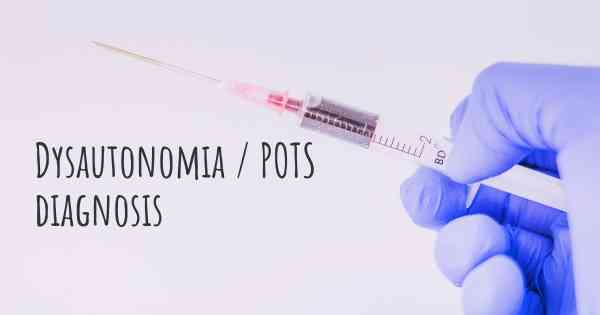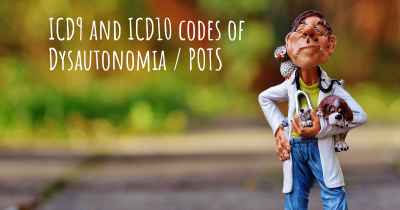How is Dysautonomia / POTS diagnosed?
See how Dysautonomia / POTS is diagnosed. Which specialists are essential to meet, what tests are needed and other useful information for the diagnosis of Dysautonomia / POTS

Diagnosing Dysautonomia / POTS
Dysautonomia refers to a group of conditions that affect the autonomic nervous system, which controls involuntary bodily functions. One specific type of dysautonomia is Postural Orthostatic Tachycardia Syndrome (POTS), characterized by an abnormal increase in heart rate upon standing up. Diagnosing dysautonomia, including POTS, involves a comprehensive evaluation of symptoms, medical history, and various diagnostic tests.
Medical History and Symptoms
The first step in diagnosing dysautonomia is a thorough medical history review. The healthcare provider will ask detailed questions about the patient's symptoms, such as dizziness, lightheadedness, rapid heartbeat, fatigue, and fainting episodes. They will also inquire about any underlying medical conditions, medications, and family history of similar symptoms.
Physical Examination
A physical examination is conducted to assess the patient's overall health and identify any signs of dysautonomia. The healthcare provider will check blood pressure and heart rate in different positions, including lying down, sitting, and standing. They may also examine the patient's reflexes, skin temperature, and perform a neurological evaluation.
Tilt Table Test
The tilt table test is a commonly used diagnostic tool for dysautonomia, including POTS. During this test, the patient lies flat on a table that can be tilted to different angles. The healthcare provider monitors the patient's heart rate, blood pressure, and symptoms while changing the table's position. This helps determine if there is an abnormal heart rate response to postural changes.
Autonomic Function Tests
Autonomic function tests evaluate the functioning of the autonomic nervous system. These tests measure various physiological responses, such as heart rate, blood pressure, sweating, and pupillary reflexes. Some commonly used autonomic function tests include:
- Heart Rate Variability (HRV) Analysis: This test assesses the variation in time intervals between heartbeats, providing insights into autonomic nervous system function.
- Sudomotor Testing: Sudomotor function is evaluated by measuring sweat production in response to different stimuli, helping assess autonomic nerve damage.
- Valsalva Maneuver: This test involves blowing into a tube against resistance while heart rate and blood pressure are monitored, assessing autonomic function.
- Quantitative Sudomotor Axon Reflex Test (QSART): QSART measures sweat production in response to electrical stimulation, aiding in the diagnosis of autonomic neuropathies.
Laboratory Tests
Laboratory tests may be ordered to rule out other potential causes of symptoms and to assess overall health. These tests can include:
- Blood Tests: Blood tests help evaluate thyroid function, blood sugar levels, electrolyte imbalances, and other factors that may contribute to dysautonomia symptoms.
- Urinalysis: Urine analysis can provide information about kidney function and detect any abnormalities.
- Autonomic Antibody Panel: In some cases, specific autoantibodies associated with dysautonomia may be tested to aid in diagnosis.
Additional Diagnostic Procedures
In certain cases, additional diagnostic procedures may be recommended to further evaluate dysautonomia symptoms. These can include:
- Echocardiogram: An echocardiogram uses ultrasound to assess the structure and function of the heart, helping identify any underlying cardiac abnormalities.
- Electrocardiogram (ECG or EKG): An ECG records the electrical activity of the heart, aiding in the detection of arrhythmias or other cardiac abnormalities.
- 24-Hour Holter Monitoring: This test involves wearing a portable ECG device for 24 hours to monitor heart rhythm and detect any irregularities.
- Electroencephalogram (EEG): An EEG measures brain wave activity and can help identify any neurological causes of dysautonomia symptoms.
Consultation with Specialists
Depending on the specific symptoms and suspected underlying causes, consultation with various specialists may be necessary. These can include cardiologists, neurologists, endocrinologists, and rheumatologists, among others. Collaboration between different specialists helps ensure a comprehensive evaluation and accurate diagnosis.
It is important to note that diagnosing dysautonomia, including POTS, can be complex and may require multiple tests and consultations. A thorough evaluation by healthcare professionals experienced in autonomic disorders is crucial for an accurate diagnosis and appropriate management.
Orthostatic Testing
Tilt-Table Test
Cardiology
Electrophysiology
Primary Care Physician
Posted Apr 19, 2017 by Nikki 2192
Posted Apr 27, 2017 by SaraW13 1050
Posted Apr 27, 2017 by Melissa 1100
Posted Aug 17, 2017 by Chelsea 2335
Posted Aug 17, 2017 by Miranda 2150
Posted Sep 27, 2017 by Lbond94 4100
Posted May 26, 2018 by Danielle 1500
A collection of symptoms, a holter monitor test, a tilt table test if it is available (on occasion there is no need for a tilt table test and on occasion you will have a patient who is a little large for the tilt table at that particular hospital or one is not available - if everything else matches up and in particular if the patient has passed out or just about passed out in front of them on changing position, standing up etc and their BP and HR has been observed, and on occasion the Holter Monitor will provide enough information. Loved ones/Carers who can back up what they have observed can also be helpful in diagnosing as well.
Generally a General Practitioner will send the patient to a Cardiologist who will do the testing and collect data and make an informed decision.
I encourage anyone who has POTS or suspects POTS to keep a diary over the space of a month with ALL symptoms, no matter how big or small, how they have felt, how dizzy they have been, any passing out, or near passing out, what was going on at the time, what foods/drinks they changed, how hydrated they were at the time....
Hydration is important as well - KEEP hydrated.... keep the salt intake up a little as well so electrolyte drinks are fabulous - NOT energy drinks - they wont do the heart rate any good.... but keep a complex food diary, mood diary, symptoms etc..... go in armed with that info to the doc and if you have a heart rate monitor - keep a record and times etc - a BP monitor is handy - either buy or borrow one.....
THeres no point getting an appointment with a cardiologist and having to go back in a month because they want all that info or you sit there going 'um...... yeh I guess so' ... it just wastes everyones time.
Posted Dec 3, 2018 by Shell 800
Posted May 30, 2017 by Valkiria 650
QHVR or balance the autonomic.
Tests as maneuver valsava, change of posture, genetic studies, and a correct medical history,
Test of vascular.
Holter
Posted Jun 2, 2017 by Aurora Saez 3201
Posted Jul 5, 2017 by Ana 2050
Posted Sep 10, 2017 by Annie 2050
Posted Nov 8, 2017 by Katerine 700








